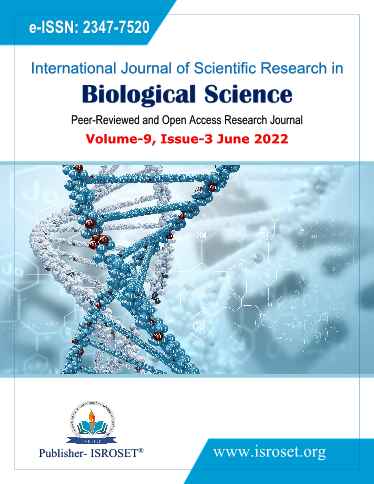Antimicrobial Activity of Indian Tea (Camellia Sinensis) Against Some Pathogenic Bacteria
Keywords:
Antimicrobial, Camellia sinensisAbstract
Every morning starts with a cup of tea and this tea lead to freshness in mouth and body. Even every guest came to the house is welcomed by a cup of tea. From ancient time, biological activity of tea is well documented by the above-mentioned effects of tea on body. Present studies were deals with, antibacterial activity of tea, against various pathogenic bacteria. The antibacterial activity of Indian tea preparation (Kadha) was studied. Antibacterial activity of green and black tea extracts was accessed by standard microbiological methods to validate traditional use of tea (Camellia sinensis) as an antibacterial agent.
References
Okeke, A.O. (2003). Three minutes herbal treatment to reduce dental caries with a Newbouldia laevis based extract. Am. J. Undergraduate Res. 2:1-4, 2003.
Hart, B.J. (2005). The evolution of herbal medicine: Behavioral perspective. Animal Behaviour. 70: 975-989, 2005.
Hamilton- Miller J.M. (1995). Antimicrobial properties of tea (Camellia sinensis L.). Antimicrob. Agents Chemother.39: 2375-2377, 1995.
Stagg, C.V., Millin, D.J. (1975). The nutritional and therapeutic value of tea: a review. J. Sci. Food Agric.26: 1439-59, 1975.
Diker, K.S., Akan, M., Hascelik, G., Yurdakok, M. (1991). The bactericidal activity of tea against Compylobacter coli. Lett. Appl. Microbiol.12:34-35, 1991.
Ryu, E., Blenden D.C., Wendall D. (1982). The inhibition of growth of selected bacteria by incorporating powdered tea in the medium. Int J. Zoonosis. 9:73-77, 1982.
Toda, M., Okubo, S., Hiyoshi, R., Shimamura, T. (1989). The bactericidal activity of tea and coffee. Lett Appl. Microbiol. 8:123-125, 1989.
Tiwari, R.P., Bharti, S.K., Kour, H.D., Dikshit, R.P., Hoondal, G.S. (2005). Synergistic antimicrobial activity of tea and antibiotics. Ind. J. Med. Res. 122:80-84, 2005.
Sakanaka, S., Kim, M., Taniguchi, M., Yamamoto, T. (1989). Antibacterial substance in Japanese green tea extract against Streptococcus mutans, a cariogenic bacterium. Agr. Biol. Chem. 53: 2307-2311, 1989.
Nakahara, K., Kawabata, S., Ono, H. et al. (1993). Inhibitory effect of oolong tea polyphenols on glucosyltransferase of mutans streptococci. Appl Environ. Microbiol. 59:968-973, 1993.
Kawamura, J., Takeo, T. (1989). Antibacterial activity of tea catechin to Streptococcus mutans. J. Jap. Soc. Food Sci. Technol. 36: 463-467, 1989.
Rasheed, A., Haider, M. (1998). Antibacterial activity of Camellia sinensis extracts against dental caries. Arch. Pharm. Res. 21: 348-352, 1998.
Muroi, H., Kubo, I. (1993). Combination effects of antibacterial compounds in green tea flavour against Streptococcus mutans. J. Agri. Food Chem. 41:1102-1105, 1993.
Otake, S., Makimura, M., Kuroki, T., Nishihara, Y., Hirasawa, M. (1991) Anticaries effects of polyphenolic compounds from Japanese green tea. Caries Res. 25: 438-443, 1991.
Hamilton-Miller, J.M.T. (2001). Anti-cariogenic properties of tea (Camellia sinensis). J.Med. Microbiol. 50: 299-302, 2001.
Yam, T.S., Shah, S., Hamilton Miller, J.M.T. (1997).Microbiological activity of whole and fractionated crude extracts of tea (Camellia sinensis) and of tea components. FEMS Microbiology Lett. 152: 169-174, 1997.
Ikigai, H., Nakae T., Hara, Y., Shimamura, T. (1993). Bactericidal catechin damage the lipid bilayer. Biochim. Biophys. Acta. 1147: 132-136, 1993.
Mabe K., Yamada, M. Oguni, I., Takahashi, T. (1996). In vitro and In vivo activities of catechins against Helicobacter pylori. Antimicrob. Agents Chemother. 43: 1788-91, 1996.
You, S.Q. (1993). Study of feasibility of Chinese green tea polyphenols (CTP) for preventing dental caries. Chung Hua Kou Chiang Hsueh Tsu Chih. 28: 197-199, 1993. (In Chinese; English abstract from medline).
Chou, C.L., Lin, L.L., Chung, K.T. (1999). Antimicrobial activity of tea as affected by the degree of fermentation and manufacturing season. Int. J. Food Microbiol. 48: 125-130, 1999.
Kubo, I., Muroi, H, Himejima, M. (1992). Antimicrobial activity of green tea flavour components and their combination effects. J. Agri. Food Chem. 40: 1102-1105, 1992.
Tsuchia, H., Sato, M., Kato, H., Okubo, T., Juneja, L.R., Kim, M. (1997). Simultaneous determination of catechin in human salivaby High performance liquid chromatography. J. Chromatog. B. Biomed. Sci. Appl. 703:253-358, 1997.
Zhang, J., Kashket, S. (1998). Inhibition of salivary amylase by black and green teas and their effects on intraoral hydrolysis of starch. Caries Res. 32: 233-23, 1998.
Downloads
Published
How to Cite
Issue
Section
License

This work is licensed under a Creative Commons Attribution 4.0 International License.
Authors contributing to this journal agree to publish their articles under the Creative Commons Attribution 4.0 International License, allowing third parties to share their work (copy, distribute, transmit) and to adapt it, under the condition that the authors are given credit and that in the event of reuse or distribution, the terms of this license are made clear.







